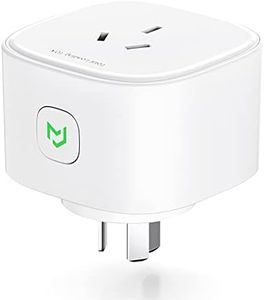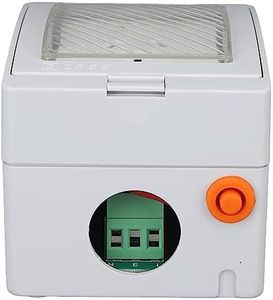We Use CookiesWe use cookies to enhance the security, performance,
functionality and for analytical and promotional activities. By continuing to browse this site you
are agreeing to our privacy policy
6 Best Outdoor Smart Plug
From leading brands and best sellers available on the web.Buying Guide for the Best Outdoor Smart Plug
Choosing an outdoor smart plug can really help you automate and control your outdoor devices, such as string lights, water fountains, holiday decorations, or garden equipment. To pick the best fit, consider how, where, and when you'll use it. You want something that's reliable, works with your existing smart home ecosystem, and handles outdoor conditions well. Always check compatibility with your home Wi-Fi and make sure it's built to last in your environment. Understanding a few key specs can make this process much easier.Weatherproof Rating (IP Rating)This spec tells you how well the plug can handle water and dust. If you're using it outdoors, it's essential that the smart plug is weatherproof. A higher IP rating (like IP65 or IP66) means better protection. IP65 indicates protection from water jets, while IP66 withstands even more powerful water exposure. If your plug will be exposed to heavy rain or near sprinklers, higher is better. If it'll be in a covered area, a slightly lower rating might be enough. Choose the level of protection based on where you'll place the plug.
Connectivity (Wi-Fi/Bluetooth)This tells you how the smart plug communicates with your phone or smart home system. Wi-Fi is common for outdoor use as it gives more range and control from anywhere with internet access. Bluetooth usually means shorter range and you need to be nearby. If you want to operate the plug when you're not at home, Wi-Fi is preferable. Always check if your home Wi-Fi covers the outdoor spot where you'll install the plug.
Smart Assistant CompatibilityMany smart plugs can be controlled using voice assistants like Alexa, Google Assistant, or Apple HomeKit. This is especially helpful if you want to manage your devices by voice commands or integrate with routines and automations. Check that the plug works with the assistant you're already using at home for a smoother experience. If you don’t use a smart assistant, app-only control might be enough.
Number of OutletsSome outdoor smart plugs come with just one outlet, while others have two or even more. More outlets let you power and control multiple devices from a single plug, but they may be bulkier. Think about how many outdoor appliances you want to automate at once; if it's just patio lights, one may be plenty, but if you want to control both lights and a pump, look for a model with at least two outlets.
Load Capacity (Amperage/Wattage)This tells you how much electrical load the smart plug can handle safely. Higher values mean it can power heavier things like pool pumps, while lower values are only for light duty like string lights. Check the devices you'll plug in and make sure the combined wattage doesn't exceed what the smart plug supports. It's always safest to choose a plug with extra capacity beyond your regular usage.
Scheduling and Timer FeaturesSmart plugs usually offer scheduling and timer functions, allowing you to automate when devices turn on or off. This is useful for things you want to run at specific times, like garden lights at dusk or a morning fountain. Check how easy it is to set and adjust these schedules in the plug’s app, especially if your needs change with the seasons.
Size and Plug DesignSize matters if you have a cramped or awkward outdoor outlet. Some smart plugs can be large and block neighboring sockets, which can be a hassle if you have more than one outdoor device to power. Look for a compact design if space is limited, and make sure it fits your outlet orientation (horizontal or vertical).





